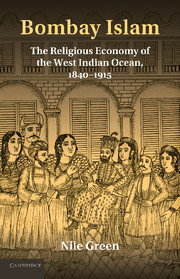Book contents
- Frontmatter
- Contents
- Illustrations
- Acknowledgements
- Maps
- Introduction
- 1 Missionaries and Reformists in the Market of Islams
- 2 Cosmopolitan Cults and the Economy of Miracles
- 3 The Enchantment of Industrial Communications
- 4 Exports for an Iranian Marketplace
- 5 The Making of a Neo-Ismā‘īlism
- 6 A Theology for the Mills and Dockyards
- 7 Bombay Islam in the Ocean's Southern City
- Conclusions
- Notes
- Bibliography
- Index
Introduction
Published online by Cambridge University Press: 03 May 2011
- Frontmatter
- Contents
- Illustrations
- Acknowledgements
- Maps
- Introduction
- 1 Missionaries and Reformists in the Market of Islams
- 2 Cosmopolitan Cults and the Economy of Miracles
- 3 The Enchantment of Industrial Communications
- 4 Exports for an Iranian Marketplace
- 5 The Making of a Neo-Ismā‘īlism
- 6 A Theology for the Mills and Dockyards
- 7 Bombay Islam in the Ocean's Southern City
- Conclusions
- Notes
- Bibliography
- Index
Summary
A RUMOUR OF MIRACLES
At 10.15 on the night of 31 May 1903, the D-block of the recently completed Sita Ram Building in Bombay ‘suddenly came down with a crash’. Most of the multi-storey building was unoccupied, but on the ground floor was a saloon bar which over the past months had done a brisk and boozy trade with the port's many British sailors. It was mainly the customers of the bar who made up the dead and injured when the building collapsed. Because the Windsor Bar stood right across the road from the shrine of a Muslim saint, rumours spread quickly that the disaster occurred through an insult to the holy man by the Hindu bar-owner and his bibulous Christian patrons. But for all his defence of the anti-alcoholic norms of sharī‘a, the saint in question was himself something of an oddity. His name was Pedro, and according to urban legend he was a Portuguese sailor who had converted to Islam two centuries earlier. This Pēdrō Shāh was no more commonplace a saint than his feat of levelling a tower block was an act of everyday grace. From his shrine's location in the heart of Bombay's bazaar district, his spectacular miracle was symptomatic of the larger pressures of cosmopolitan modernity that helped create a marketplace of religions in the city surrounding him.
- Type
- Chapter
- Information
- Bombay IslamThe Religious Economy of the West Indian Ocean, 1840–1915, pp. 1 - 23Publisher: Cambridge University PressPrint publication year: 2011



